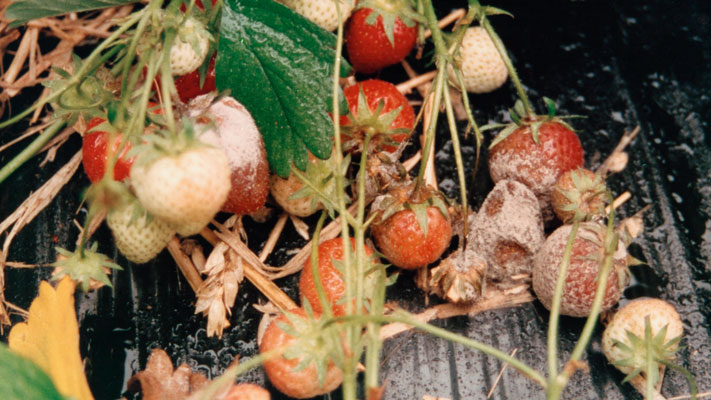Botrytis grey mould of lentils
Botrytis grey mould (BGM) is a severe but sometimes sporadic foliar disease of Australian lentil crops caused by Botrytis cinerea and Botrytis fabae. All above ground parts of lentils can be infected, resulting in yield losses of up to 30 per cent in conditions which favour the development of the disease i.e. early-sown, dense crops with good spring rainfall and prolonged wet periods. Lentil seed can also become discoloured, resulting in quality downgrades. Other hosts of BGM include faba beans, chickpeas and a range of ornamental and horticultural crops.

Description
If humid conditions exist for at least four days, the disease can spread from the leaves to the lower stems. The disease girdles the stems, causing the plants to ripen prematurely before the stems become covered in a furry, grey mould which eventually results in stem and possibly plant death. Pods can also become covered in mould and the seeds within fail to develop properly and are commonly shrivelled and discoloured. The spore masses from the mould are easily spread onto susceptible plant material. If conditions remain wet during spring, patches of brown dying plants are evident in the paddock.
BGM can survive on infected seed, infected trash, on alternate hosts or as sclerotia in the soil. If infected seed is sown, the seedlings also become infected resulting in poor crop establishment. Spores from trash are easily spread by wind and under humid conditions, the disease can spread quickly.
Refer to the links below for more detailed information on Botrytis cinerea in other crops.
Control
- Using varieties with a high resistance to BGM but note all varieties are susceptible under high disease pressure
- Use clean seed
- Use a registered seed treatment to control seed-borne diseases
- Avoid sowing lentils in paddocks near disease hosts such as old lentil, faba bean, chickpea, vetch or lathyrus stubbles
- Avoid early sowing, choosing appropriate sowing dates and rates to avoid producing a humid environment which enhances disease development
- Apply foliar fungicides before canopy closure in high risk situations and if necessary, apply follow up applications 12 – 14 days later
- Plan to harvest as early as possible to minimise disease on the seed.
References
Agriculture Victoria (2016), ‘Botrytis Grey Mould of Lentil’, Note Number AG1275, http://agriculture.vic.gov.au/agriculture/pests-diseases-and-weeds/plant-diseases/grains-pulses-and-cereals/botrytis-grey-mould-of-lentil
CropPro (Viewed December 2019), ‘Botrytis Grey Mould of Lentil’, http://www.croppro.com.au/crop_disease_manual/ch08s03.php
Davidson, J and Lindbeck, K (2016)/ Botrytis Grey Mould of Lentil’, GRDC Communities, https://communities.grdc.com.au/field-crop-diseases/botrytis-grey-mould-of-lentil/





